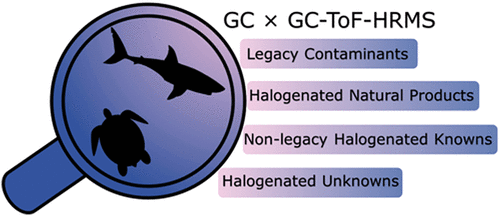当前位置:
X-MOL 学术
›
Environ. Sci. Technol.
›
论文详情
Our official English website, www.x-mol.net, welcomes your feedback! (Note: you will need to create a separate account there.)
Characterization of Halogenated Organic Compounds in Pelagic Sharks and Sea Turtles Using a Nontargeted Approach
Environmental Science & Technology ( IF 11.4 ) Pub Date : 2021-11-30 , DOI: 10.1021/acs.est.1c03798 Aikebaier Renaguli 1 , Sujan Fernando 2 , Thomas M Holsen 2, 3 , Philip K Hopke 2 , Douglas H Adams 4 , George H Balazs 5 , T Todd Jones 5 , Thierry M Work 6 , Jennifer M Lynch 7, 8 , Bernard S Crimmins 3, 9
Environmental Science & Technology ( IF 11.4 ) Pub Date : 2021-11-30 , DOI: 10.1021/acs.est.1c03798 Aikebaier Renaguli 1 , Sujan Fernando 2 , Thomas M Holsen 2, 3 , Philip K Hopke 2 , Douglas H Adams 4 , George H Balazs 5 , T Todd Jones 5 , Thierry M Work 6 , Jennifer M Lynch 7, 8 , Bernard S Crimmins 3, 9
Affiliation

|
Halogenated organic compounds (HOCs) in marine species collected from the Atlantic Ocean [3 shortfin mako (Isurus oxyrinchus) and 1 porbeagle (Lamna nasus)], and 12 sea turtles collected from the Pacific Ocean [3 loggerhead (Caretta caretta), 3 green (Chelonia mydas), 3 olive ridley (Lepidochelys olivacea), and 3 hawksbill (Eretmochelys imbricata)] were analyzed with a nontargeted analytical method using two-dimensional gas chromatography coupled to high-resolution time-of-flight mass spectrometry. Sharks and sea turtles had distinct HOC profiles. Halogenated methoxyphenols (halo-MeOPs) were the most abundant compound class identified in sea turtle livers, while polychlorinated biphenyls (PCBs) were the most abundant in shark livers. In addition to legacy contaminants and halo-MeOPs, a total of 110 nontargeted/novel HOCs (NHOCs) were observed in the shark livers. Shortfin mako collected from the northern Gulf of Mexico contained the largest number (89) and most diverse structural classes of NHOCs. Among all NHOCs, a group of compounds with the elemental composition C14H12–nCln (n = 5–8) exhibited the highest concentrations, followed by chlorocarbazoles and tris(chlorophenyl) methanes (TCPMs). Using nontargeted workflows, a variety of known and unknown HOCs were observed, which demonstrate the need to develop more complete chemical profiles in the marine environment.
更新日期:2021-12-21


























 京公网安备 11010802027423号
京公网安备 11010802027423号